- April 2018
- March 2018
- February 2018
- January 2018
- December 2017
- November 2017
- October 2017
- September 2017
- August 2017
- July 2017
- June 2017
- May 2017
- April 2017
- March 2017
- February 2017
- January 2017
- 2017
- 2016
- 2015
- 2014
- 2013
News : September 2015
Nation-wide Letter Writing Competition 2015 by India Post.
India Post will be conducting a Nation-wide Letter Writing Competition for school children during the National Postal Week, 2015.
Some of the salient features of the competition are:
* The Competition will be held in two categories: Junior (up to Class V); Senior (Class VI to X).
* The letter is to be addressed to the ‘Grandparents’.
* Children may choose to write on any one of the following themes:
1. How did I spend my vacation
2. One day in my school
3. My favourite book
* The letter can be written on Inland Letter Card (ILC) or A4 paper.
* The Department will provide stationery/ILC/envelopes/stamps for posting the letters to their grandparents.
*
Children should bring the complete postal address with PIN Code, of their grandparents.
*
Top three letters of each Division should be given suitable prizes and the same would be sent to Circle Office for State Level evaluation and then to New Delhi for All India Level evaluation.
*
Children would be introduced to Philately and information about opening and maintaining Philately Deposit Accounts (PDA), with the purpose of encouraging them to develop interest in Philately and open PDA.
India Post would like to encourage the students to participate in large numbers and win exciting prizes…!

See Press Release of Chennai City Region.
Special Cover on Jain Saint Jayanand Muni Maharaj – 30th September 2015.
On the occasion of 10th Swargarohan Anniversary of Jain Saint Pujya Jayanand Muni Maharaj, a Special Cover was issued at Jaipur on 30th September 2015. Release function was organised at Mohanbadi, Galta Gate, Jaipur in the auspicious presence of Pujya Maitryprabh Sagar ji Maharaj. Shri J. M. Dhor, President, Jaipur Philatelic Society was instrumental in release of this special cover and special cancellation.
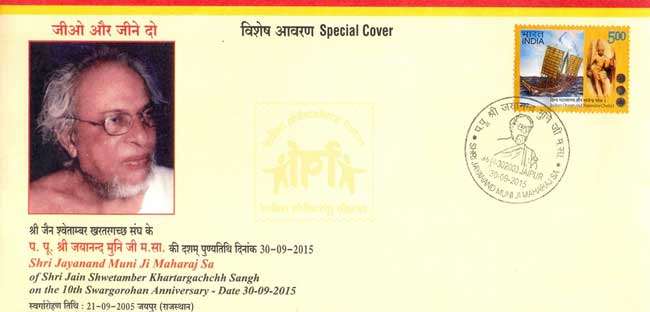
Courtesy: Sudhir Jain, Satna
Commemorative Stamp on Dr. B. R. Ambedkar & Constitution of India - 30th September 2015.
 Dr Bhimrao Ramji Ambedkar (b. 14 April 1891 – 6 December 1956), popularly known as Babasaheb Ambedkar, was one of the architects of the Indian Constitution. He was born to Bhimabai Sakpal and Ramji on 14 April 1891 in Madhya Pradesh.
Dr Bhimrao Ramji Ambedkar (b. 14 April 1891 – 6 December 1956), popularly known as Babasaheb Ambedkar, was one of the architects of the Indian Constitution. He was born to Bhimabai Sakpal and Ramji on 14 April 1891 in Madhya Pradesh.
Babasaheb was a well-known politician, economist, social reformer and an eminent jurist. Ambedkar's efforts to eradicate the social evils like untouchablity and caste restrictions were remarkable. The leader, throughout his life, fought for the rights of the dalits and other socially backward classes. Ambedkar was appointed as the nation's first Law Minister in the Cabinet of Jawaharlal Nehru. Bhimrao Ambedkar was appointed as the chairman of the constitution drafting committee. Ambedkar emphasized on the construction of a virtual bridge between the classes of the society. According to him, it would be difficult to maintain the unity of the country if the difference among the classes were not met. He was posthumously awarded the Bharat Ratna, India's highest civilian honor in 1990.
The Union Minister for Communications & Information Technology, Shri Ravi Shankar Prasad released the Commemorative Stamp on Dr. B.R. Ambedkar’s 125th Birth Anniversary Year, in New Delhi on 30th September, 2015. The Union Minister for Social Justice and Empowerment, Shri Thaawar Chand Gehlot and the Minister of State for Social Justice & Empowerment, Shri Vijay Sampla were also present on the occasion.


Courtesy: PIB
Special Cover on Sesquicentennial of Government College of Art and Craft, Calcutta – 29th September 2015.
The Government College of Art & Craft in Kolkata is the oldest heritage institution imparting art education in Kolkata. The genesis of this institution can be traced back to 1864 at Garanhata, from where it changed location several times before getting housed in the present building on Chowringhee Road towards the end of the 19th century. With the patronage of the British government and men of letters of the day, the Art School metamorphosed into a College in the 20th century, soon after India’s independence. Under the aegis of Abanindranath Tagore it grew into prominence and was reckoned as a premier art institution across the country. Artists spawned by this College contributed in no small measure to the Indian national movement and the Indian renaissance. It is from the womb of this institution that artists like Nandalal Bose, Jamini Ray, Asit Haldar, Hemen Majumdar, Atul Basu and Jainal Abedin were born. With the passage of time, these names were celebrated as the most luminous stars from South Asia in art, the world over.
The Government College of Art and Craft completed a hundred and fifty years of its existence this year. The concluding part of the sesquicentennial celebration was held in the premises of the Government College of Art and Craft, Kolkata on the 29th September, 2015. A Special Cover was released to commemorate Sesquicentennial of Government College of Art and Craft, Calcutta on the occasion by Minister of Education, West Bengal, Dr. Partha Chatterjee in presence of Mayor of Kolkata, Sri Sovon Chattopadhyay and Ms. Arundhaty Ghosh, Chief Post Master General, West Bengal Postal Circle (Special Cover approval no. WB/09/2015).

Cover Courtesy: Suresh Rao, Bengaluru
Special Cover on St. Michael's High School, Patna – 28th September 2015.
St. Michael’s High School, located at Digha Ghat in Patna, is a premier Catholic Missionary educational institution, founded in 1858, by the first Bishop of Patna, Dr. Anastasius Hartmann. Begun as a boarding school for poor and orphan boys under the Catholic Chruch at Kurji, the School has witnessed tremendous growth in terms of strength of students on its rolls, and physical infrastructure. In 1894, the management of the School was handed over to the Irish Christian Brothers, well-known for their all-round education to students particularly through boarding and hostels. It became a high school, and sent up the first batch of four students to high school examination in 1896. Since 1968, the School is managed by the Patna Jesuit Society, the Bihar provincial unit of the world-wide Catholic missionary organization called the Society of Jesus (Jesuit Society). St. Michael’s High School is affiliated to the Central Board of Secondary Education for the All India Secondary School Examination (Class X) and the All India Senior School Certificate Examination (Class XII).
St Michael's High School celebrated its feast day at the school premises on 28th September 2015. On the occasion a Special Cover was released by Shri R. V. Choudhary, Senior Superintendent of Post Offices, Patna Division (Special Cover approval No. BH-09/SEP 2015). A philately counter was also set up for the students at the school premises and ‘My Stamp’ facility was also made available at the counter.
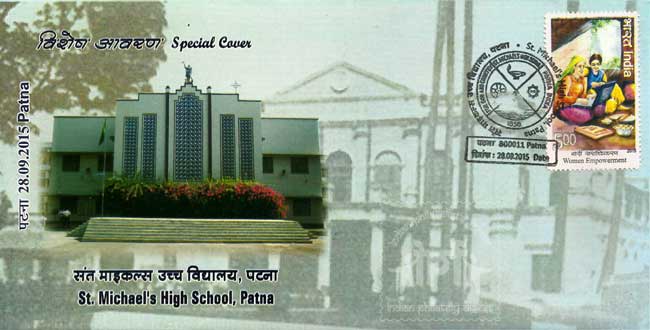
Courtesy: Lalit Kumar Mishra, Patna
Special Cover on World Tourism Day – 27th September 2015.
With the multitude of colors and vivid shades of its rich culture, Jaipur celebrated the World Tourism Day on 27 September, 2015. The objective behind this day is to create awareness among the common people for conserving and protecting our heritage. On the World Tourism Day, all of the government regulated monuments entries were kept free to promote and attract the tourists. Tourists were welcomed in the monuments in Indian cultured music ceremony and tourists were accorded floral reception at various monuments like Amber Fort, Elephant Stand, Albert Hall, Jantar Mantar, City Palace and Hawa Mahal.
On the occasion a ‘My Stamp’ kiosk was opened at Hawa Mahal. To mark the World Tourism Day and to commemorate the inauguration of My Stamp facility at Hawamahal a Special Cover was released on 27th September 2015 at Jaipur.
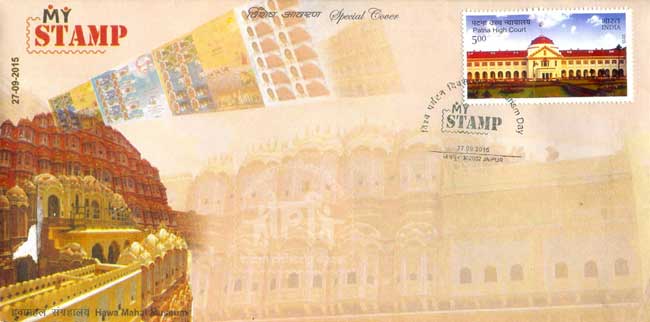
Cover Courtesy: Sreejesh Krishnan, Thiruvananthapuram
Special Cover on Uttar Pradesh Sindhi Academy, Lucknow - 26th September 2015.
Uttar Pradesh Sindhi Academy is set up to provide a forum to the Sindhi Community and for the promotion of Sindhi language and Sindhi literature in Uttar Pradesh. On the occasion of 55th Nirvan Mahotsav of Sakhi Baba Adudaram Saheb a Special Cover on Uttar Pradesh Sindhi Academy, Lucknow was released at Lucknow on 26th September 2015.
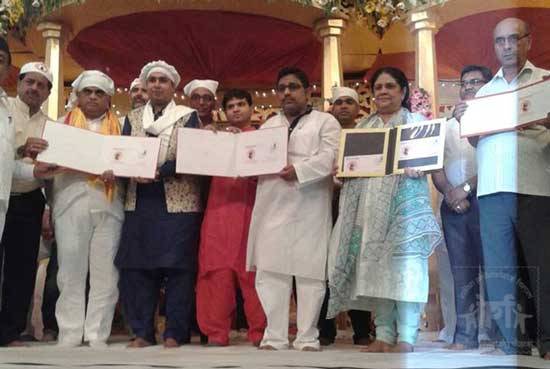
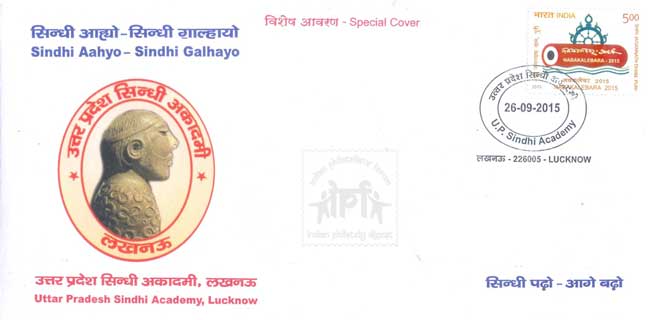
Cover Courtesy: Sreejesh Krishnan, Thiruvananthapuram
New Series of Picture Postcards released by North Karnataka Postal Region & Karnataka Postal Circle.
Two sets of Picture Postcards have been released by North Karnataka Postal Region and Karnataka Postal Circle.
One set of 48 Picture Postcards on ‘Birds of the Himalayas - International Biodiversity Decade 2011-2020’ has been released by North Karnataka Postal Region, Dharwad. This is second set in the series. Set of 48 cards is priced at Rs. 150.
Another set of 12 Special Postcards on theme ‘Namma Karnataka, One State Many Worlds’ has been released by Karnataka Postal Circle. Set of 12 cards is priced at Rs. 125.

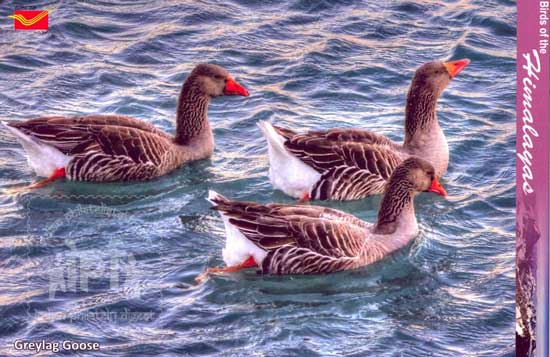
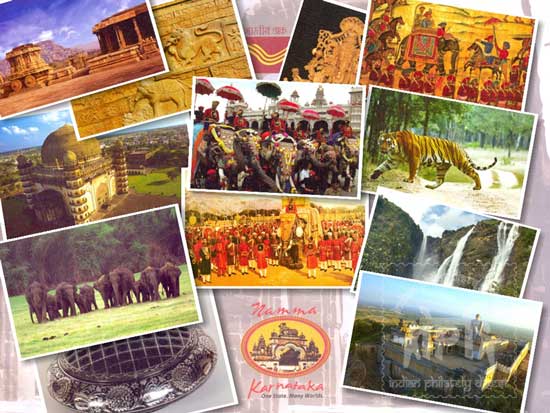
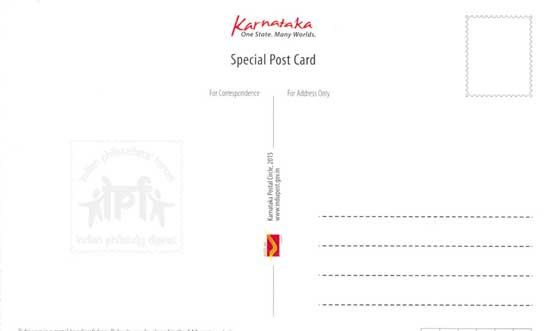
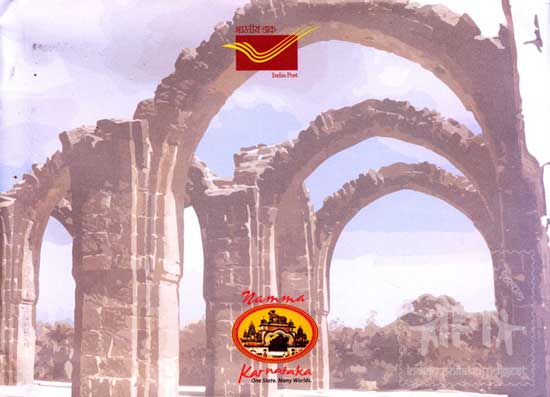
Courtesy: Suresh Rao, Bengaluru
Doon Philatelic Club : New Philatelic Club formed at Dehradun - 19th September 2015.
A group of philately enthusiasts of Dehradun city have formed Doon Philatelic Club with an objective to promote philately in Dehradun. A meeting of local philatelists was convened at the residence of Mrs. Jeevan Jyoti on 19th September 2015 at Dehradun. The meeting was attended by Shri P. C. Agrawal, Shri Gunjan Maithel, Smt. Anita Maithel, Shri Rajesh Verma, Shri Abhai Mishra, Shri Ajay Srivastav and Smt. Jeevan Jyoti. The objective of this club is to promote philately in Dehradun. Following are the governing council members of Doon Philatelic Club:
President: Shri Prem Chand Agrawal
General Secretary: Shri Gunjan Maithel
Members: Smt. Anita Maithel, Shri Rajesh Verma, Shri Abhai Mishra, Shri Ajay Srivastav, Smt. Jeevan Jyoti
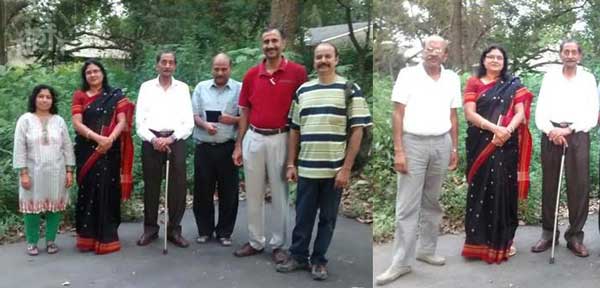
L to R : Smt. Jeevan Jyoti, Smt. Anita Maithel, Shri P. C. Agrawal, Shri Ajay Srivastav, Shri Abhai Mishra, Shri, Rajesh Verma and Shri Gunjan Maithel
Courtesy: Jeevan Jyoti, Dehradun
Special Cover on Golden Jubilee of INS Agrani – 18th September 2015.
It was on August 18, 1965 that a building within the military establishment in Coimbatore was dedicated to a training school for petty officers and chief petty officers of Indian Navy. Initially set up as one of the changes to decongest the naval base in Kochi, the school began offering only a training course in leadership to petty officers in the navy. The training school which grew into the iconic INS Agrani, named after the Sanskrit word Agrani which means 'leader'. The school, which evolved over the years, is the only establishment in the Indian Navy that trains all senior sailors from various branches under one umbrella. The multi dimensional role of Agrani involves Leadership and Management training, administering the Naval Shooting Team and supporting the Aircraft and Engine Holding Unit along with housing the Naval Selection Board.
The leadership training establishment INS Agrani of the Indian Navy celebrated its Golden Jubilee from 18th to 20th September 2015 at Coimbatore. To commemorate Golden Jubilee of INS Agrani a Special Cover was released by Flag Officer Commanding-in-chief, Vice-Admiral, Sunil Lanba and Postmaster General, Coimbatore, Ms. Manju P. Pillai on 18th September 2015 (Special Cover approval No. TN/20/2015).

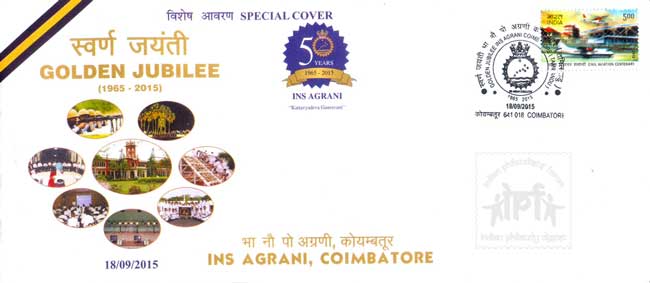
Cover Courtesy: Sreejesh Krishnan, Thiruvananthapuram
Special Cover on Salkhan Fossils – 18th September 2015.
Salkhan Fossil Park is a place in Sonebhadra District of Eastern Uttar Pradesh having oldest fossils of the world. This place is located about 12 kilometers away from Robertsganj town in Sonebhadra District on the Varanasi-Renukut Highway (SH-5) at Salkhan village. It is regarded as one of the most important destination to know the Earth’s geological and biological past. Salkhan Fossil Park presents evidence regarding emergence and the initial stages of evolution of life on the Earth. Thus the fossil park has invaluable possession not only for India but for the entire world. The age of fossils found in Salkhan village are approximately 1,500 million years old and dates back to Mesoproterozoic period according to geological time scale. The fossils found in the Sonebhadra Fossils Park are algae and stromatolites types of fossils and appear as rings on the boulders scattered around the area.
Salkhan Fossils Park, officially known as Sonebhadra Fossils Park, is spread over an area of about 25 hectares in Kaimur Wildlife range adjacent to Kaimur Wildlife Sanctuary. The circumference of the fossil park is 3.5 kilometers and it is larger than the National Yellow Stone Naional Park of USA.
A Special Cover was released to commemorate Salkhan Fossils on 18th September 2015 at Sonebhadra.
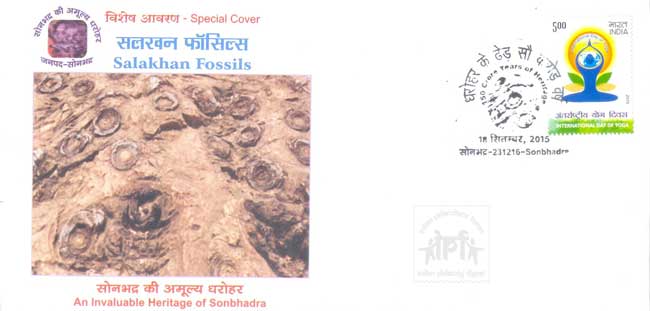
Image Courtesy: Sreejesh Krishnan, Thiruvananthapuram
Special Cover on Bharat Ratna Dr. M. S. Subbulakshmi – 16th September 2015.
Madurai Shanmukhavadivu Subbulakshmi, (b. 16 September 1916 – d. 11 December 2004), also known as M.S. or, M. S. Subbulakshmi was a renowned Carnatic vocalist. She was the first musician ever to be awarded the Bharat Ratna, India's highest civilian honour. She is the first Indian musician to receive the Ramon Magsaysay award, often considered Asia's Nobel Prize in 1974 with the citation reading "Exacting purists acknowledge Srimati M. S. Subbulakshmi as the leading exponent of classical and semi-classical songs in the carnatic tradition of South India."
Subbulakshmi (Kunjamma to her family) was born in Madurai to veena player Shanmukavadiver Ammal and Subramania Iyer. She started learning Carnatic music at an early age and trained in Carnatic music under the tutelage of Semmangudi Srinivasa Iyer and subsequently in Hindustani music under Pandit Narayanrao Vyas. Her mother, from the devadasi community, was a music exponent and a regular stage performer, and Subbulakshmi grew up in an environment very conducive to musical learning. Her musical interests were also shaped by regular interactions with Karaikudi Sambasiva Iyer, Mazhavarayanendal Subbarama Bhagavathar and Ariyakudi Ramanuja Iyengar. Subbulakshmi gave her first public performance, at the age of eleven, in the year 1927, in the 100 pillar hall inside the Rockfort Temple, Tiruchirappalli; with Mysore Chowdiah on the violin and Dakshinamurthy Pillai on the mridangam. By the age of seventeen, Subbulakshmi was giving concerts on her own including major performances at the Madras Music Academy. She travelled to London, New York, Canada, the Far East, and other places as India's cultural ambassador. M.S. also acted in a few Tamil films in her youth.
A four-day centenary festival of the legendary Carnatic musician, late Dr. M. S. Subbulakshmi was held at Shri Shanmukhananda Fine Arts and Sangeetha Sabha, Mumbai from 13th to 16th September 2015. On the occasion a Special Cover on Dr. M. S. Subbulakshmi was released by Shri Devendra Fadnavis, Chief Minister of Maharashtra on 16th September 2015 (Special Cover approval no. MH/26/2015).


Courtesy: Sreejesh Krishnan, Thiruvananthapuram
Commemorative Stamps on "Valour and Sacrifice-1965 War" - 15th September 2015.
Honour, selfless service and the spirit of sacrifice are ingrained tenets of the Indian Armed Forces, preserved as part of their glorious tradition, enabling them to acquit themselves commendably both in war and peace. In the face of grave personal danger, the Indian Soldier, Sailor and Air Warrior have never hesitated in making the supreme sacrifice in the line of duty. The same has been amply evident throughout the history of our Nation, in the face of many challenges faced. One such example of a Glorious Victory was witnessed in 1965, wherein our Armed Forces exhibited tremendous grit, determination and fortitude; living up to the faith reposed in them by the Indian Nation and its leaders.
The glory of the 1965 War is preserved in the collective bravery displayed by the Indian Armed Forces, possible largely because of the ardent support of the entire Nation. This glory has been recognised through the award of 16 Battle Honours and three Theatre Honours, two PVCs besides numerous MVCs, VrCs and Mentions-in-Despatches. The heroism of CQMH Abdul Hamid and Lt Col AB Tarapore, who were posthumously awarded the Param Vir Chakra will live on in the glorious history of our Nation. The history of the Glorious Victory of the Indian Armed Forces in 1965 is testimony to the credo that the Safety, Honour and Welfare of the country comes first, always, and every time, for the Indian Armed Forces.
To commemorate 50 years of the Glorious Victory of 1965 Indo – Pak War six day long exhibition ‘Shauryanjali’ has been organized by Armed Forces at India Gate lawns. The Exhibition recreates all the major battle scenes of the 1965 war and brings back the nostalgic events where our soldiers not only successfully defended the border of the country but also made territorial gains in Pakistan. The Exhibition is open to the general public from 15th September, 2015 to 20th September, 2015 from 9 am to 9 pm.
On the occasion a set of three commemorative stamps on theme "Valour and Sacrifice-1965 War" was released by the Union Minister for Communications & Information Technology, Shri Ravi Shankar Prasad at the Exhibition at India Gate, in New Delhi on 15th September, 2015. The Stamps depicts the spirit and resoluteness of purpose displayed by the three wings of Indian Armed Forces during the 1965 war and how the Nation stood with the soldier in the bond of brotherhood which is so vital for the defence of the Motherland.

 |
 |
 |

Photo Courtesy: PIB
Special Cover on B. R. Jain - 13th September 2015.
A special cover was released on well-known Industrialist and Jain Social worker Shri Balwant Rai Jain was released at Bhilai on 13th September 2015 during Twincitypex-2015 philatelic exhibition.
Shri Balwant Rai Jain was a Chairman of Bhilai Engineering Corporation and National President of Akhil Bharatiya Digambar Jain Parishad. Apart from being an eminent industrialist, he was also known for his dedication towards social welfare and educational activities. He was born in 1923 at Najafgarh in Delhi. His father was an official in the Central Government. After completing primary education in Najafgarh, he pursued degree course in Engineering from Banaras Hindu University, and subsequently worked for three years in different factories in Delhi. In 1948, he started his own business, before switching to the work as contractor of steel fabrication in Bhilai Steel Plant. In 1960, he established an industry of manufacturing accessories of steel plant. In 1984, Jain set up a super phosphate plant in Bilaspur and in 1992, a food processing unit in Durg. He passed away on 23rd February 2014 at Bhilai.
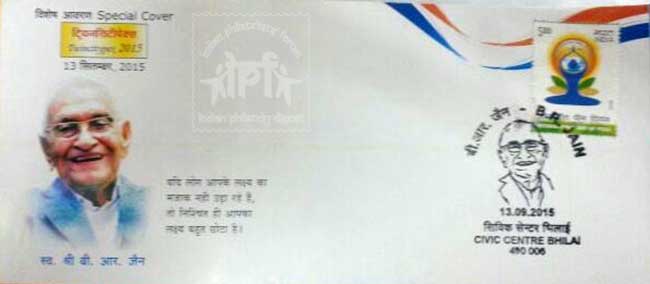
Courtesy: Sudhir Jain, Satna
Drawing Competitions & Philatelic Quiz Competition at Gorakhpur.
Gorakhpur Postal Division organized a drawing competitions and divisional level philatelic quiz competition on 6th September 2015 and a regional level philatelic quiz competition on 13th September 2015 at Gorakhpur.
The winner of these competitions will participate in 1st zonal level philatelic exhibition Uttarpex-2015 organized by UP & Uttarakhand Postal Circle from 29th October to 1st November 2015.
Winners of the drawing competitions:
Basic Class (Upto V Std.)
1st - Km.Sagarika Verma, Class: III, SVM Public School, Gorakhpur
2nd - Pravesh Agrawal, Class: III, St. Joseph School, Gorakhpur
3rd - Km Pragati Patil, Class: III, St. Joseph School, Gorakhpur
Junior Class (VI to VIII Std.)
1st - Km. Akansha Yadav, Class: VIII, G. N. National Public School, Gorakhpur
2nd - Km. Ankita Gupta, Class: VIII, Carmel Girls Inter College, Gorakhpur
3rd - Sagar Chowdhary, Class: VIII, M. P. Inter College, Gorakhpur
Senior Class (IX to XII Std.)
1st - Km. Pooja Chaurasia, Class: XII, Jawahar Navodya, Gorakhpur
2nd - Km.Swati Singh, Class: XI, Carmel Girls Inter College, Gorakhpur
3rd - Km. Juhi Shukla, Class: X, Jawahar Navodaya, Gorakhpur
Winner of Philatelic Quiz Competition:
1st - Gaurav Nanadan Tripathi: Class: XI, G. N. Natioanl Public School, Gorakhpur
2nd - Siyva Prakash Yadav, Class: VIII, Jawahar Navodaya Vidalaya, Gorakhpur
Shri Sandeep Chaurasia, Shri Himanshu Singh, Shri Raman Kumar Mandal, Philatelists and Shri Sanjay Kumar Tripathi, Asstt. Supdt. (Vig) from Department of Posts were member of jury for all competitions.


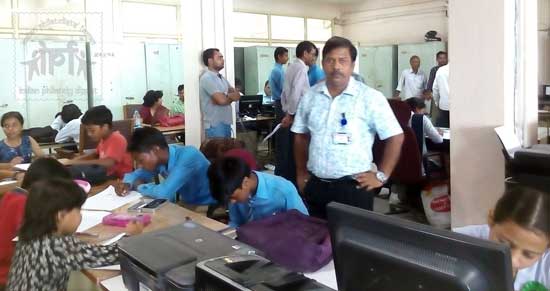
Courtesy: Sandeep Chaurasia, Gorakhpur
Chittorgarhpex 2015, district level philatelic exhibition - 11th – 13th September 2015.
Chittorgarhpex 2015, First district level philatelic exhibition of Chittorgarh district, Rajasthan was held at Chittorgarh from 11th to 13th September 2015. During the exhibition two special covers were released.
Special Cover on Meera Temple, Chittorgarh Fort – 11th September 2015.
On 11th September 2015 a Special Cover on Meera Temple of Chittorgarh Fort was released by Lt. Col. Shri DKS Chauhan, Chief Postmaster General, Rajasthan Postal Circle, Shri S. R. Meena, Postmaster General, Ajmer Region, Shri S. L. Bhambhi, Supdt. of Posts, Chittorgarh and Shri Virendra Sharma, philatelist (Jury member). Special cover depicts Meera temple and a view of Chittorgarh fort and the cancellation depicts sketch of Meerabai as devotee of Lord Krishna.
Meerabai temple located in the Chittorgarh fort was built in North Indian manner, which has an open arcade in the region of the chamber with four pavilions in each angle. It is in south of Kumbha Shyam Temple. It is said that on the request of Meerabai, a mystic poetess devoted to Lord Krishna, her father in law Maharana Sangram Singh I, built a small Lord Krishna temple near the Kumbh temple. Kumbh temple is famously known as Kumbha Shyam Temple (Temple of Varah) which was built by Maharana Kumbha in 1449. There is also a small Chhatri in the temple which was built in the memory of Meerabai’s spiritual teacher, Rai Das (Swami Ravidas) of Varanasi.

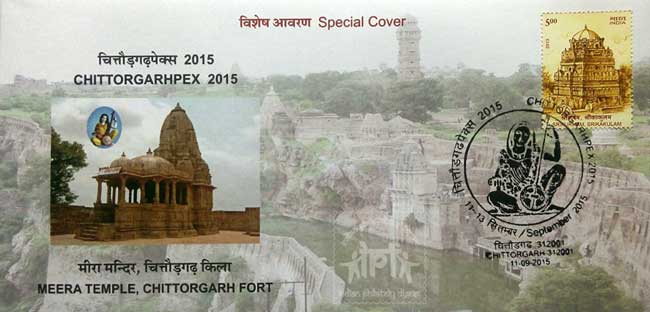
Special Cover on Thewa Art - 13th September 2015.
On 13th September 2015 a special cover was released on famous Thewa Art of Pratapgarh district by Shri C. P. Joshi, Member of Parliament.
Thewa Art is a special art of jewellery making which involves embossing of intricately worked-out sheet gold on molten glass. It is a traditional art of fusing 23K Gold with multicoloured glass. The glass is treated by a special process to have glittering effects, which in turn highlights the intricate gold work. This art evolved in Pratapgarh district of Rajasthan. The Thewa art originated about 300 years ago. History tells that Nathu Lal Sonewal was the first goldsmith who initiated this style in 1707. It soon caught the fancy of kings and princes and Maharaja Sumant Singh patronized this art in 1765 and granted a jagir to the family of Nathu Lal Sonewal and conferred the title of Rajsoni on him. This craft flourished especially during the Victorian times when a number of pieces set in gold were sold to British women who lived or visited India. These pieces were taken to Europe as souvenirs. Somehow they found their way to the British antique market and the work was recognized by European jewellery historians for its distinction. Some pieces about 250 years old can still be seen in the collection of Queen Elizabeth. Besides jewellery pieces non-jewellery thewa decorated objects include trays, plate, photo frame, wall clock, ashtray, pandents, saree-pin (brouch), button-set, betel-nut containers, rose water sprinklers, cigarette boxes, card boxes, flower vases, cuff-links and perfume bottle etc. Thewa art reflects the royal life style of Rajasthani and Mogul kings.
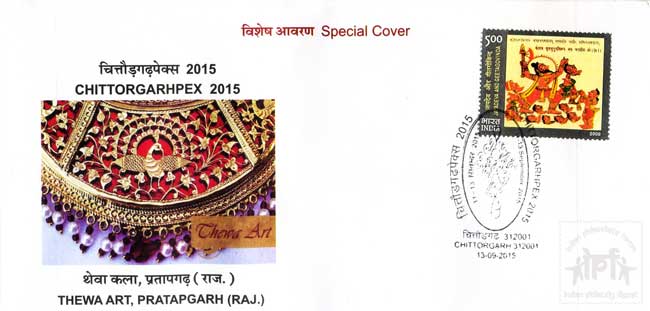
Courtesy: Virendra Sharma | Rajesh Sharma, Udaipur
Commemorative Stamp on 10th World Hindi Conference - 10th September 2015.
![]() The tradition of the World Hindi Conferences began with the first conference having been organized in Nagpur and inaugurated on 10th January, 1975 by Smt. Indira Gandhi, the Prime Minister of India. A commemorative stamp was released on this occasion. Since then, these conferences have achieved a global profile and momentum of their own. The subsequent World Hindi Conferences were organized in different countries, namely, twice in India (Nagpur: 10-12 January, 1975 and New Delhi: 28-30 October, 1983), twice in Mauritius (Both in Port Louis: 28-30 August, 1976 and 02-04 December, 1993), Trinidad and Tobago (Port of Spain: 04-08 April, 1996), UK (London: 14-18 September, 1999), Suriname (Paramaribo: 06-09 June, 2003), USA (New York: 13-15 July, 2007) and South Africa (Johannesburg: 22-24 September, 2012).
The tradition of the World Hindi Conferences began with the first conference having been organized in Nagpur and inaugurated on 10th January, 1975 by Smt. Indira Gandhi, the Prime Minister of India. A commemorative stamp was released on this occasion. Since then, these conferences have achieved a global profile and momentum of their own. The subsequent World Hindi Conferences were organized in different countries, namely, twice in India (Nagpur: 10-12 January, 1975 and New Delhi: 28-30 October, 1983), twice in Mauritius (Both in Port Louis: 28-30 August, 1976 and 02-04 December, 1993), Trinidad and Tobago (Port of Spain: 04-08 April, 1996), UK (London: 14-18 September, 1999), Suriname (Paramaribo: 06-09 June, 2003), USA (New York: 13-15 July, 2007) and South Africa (Johannesburg: 22-24 September, 2012).
The objective of the World Hindi Conference is the promotion of Hindi globally as a world language. Hindi in its different forms is spoken in a large number of countries that extend across the globe, from countries with small Hindi speaking communities to countries where a substantial minority of the population speak Hindi such as Mauritius, Suriname, Fiji etc. Hindi is not restricted to people of Indian origin; there have been many eminent scholars of Hindi based in Europe who have contributed to the study of the language. World Hindi conferences aim at recognition of Hindi as a language of not only literature but also a language that is capable of adapting itself to modern science and technology.
The 10th World Hindi Conference (WHC) is organized from 10-12 September 2015 in the city of Bhopal at Lal Parade Ground by the Ministry of External Affairs, Government of India in partnership with the Government of Madhya Pradesh. The decision to organize the 10th edition of the Conference in India was taken at the 9th World Hindi Conference held in Johannesburg, South Africa in September 2012.
The 10th World Hindi Conference is inaugurated by Prime Minister Shri Narendra Modi on 10th September 2015 at Bhopal and on the occasion he released a commemorative stamp on 10th World Hindi Conference in presence of Minister of Communications and Information Technology Shri Ravi Shankar Prasad, Minister of External Affairs Smt. Sushma Swaraj and other dignitaries.
![]()
Photo Courtesy: PIB
Thanjaipex 2015, Thanjavur District Level Philatelic Exhibition - 3rd to 4th September 2015.
Thanjaipex 2015, Thanjavur District Level Philatelic Exhibition was organized on 3rd and 4th September 2015 at Thanjavur by Thanjavur Postal Division at Perarignar Anna Nootrandu Kalaiarangam (Near Old bus stand and opposite to RM Hospital), Thanjavur, Tamilnadu.
The exhibition was inaugurated by Shri J.T. Venkateswarlu, Postmaster General, Central Region, Tamil Nadu, in the presence of V. Badrinath, Dean, School of Management, SASTRA University, and G. Natarajan, Director of Postal Services, Central Region. Five special covers on “Art and musical icons of Thanjavur” and a booklet on “International day of Yoga” Stamp were released on the occasion. During the exhibition philatelic workshop and quiz competition were also organized for students.


First special cover released on 3rd September 2015 was on musical instrument Veena (Veenai) of Thanjavur (Special Cover approval no. TN/24/2015).
The veena or veenai is India’s national instrument, and one of our most ancient ones. It is considered as the queen of Indian musical instruments. The present form of the veena is a polyphonous instrument designed and developed by Govinda Dikshitar during the reign of Raghunath Naik of Tanjore. It is often called the Tanjore veena or the Saraswati Veena. The veena is four feet in length consisting of a large resonator (kudam), a wooden bridge (kudurai), a tapering hollow neck (dandi), a smaller non-functional resonator and seven strings of the Veena. Jackfruit trees are used for making veenai. Veenai is made from jackfruit tree, which was grown for more than hundred years. The trunk of this tree does not grow big just like other trees.The making of resonator by chipping away the lump of wood to make a round, smooth surface it takes about five days. Making the inside of the foot-high kudam will take another week’s time. It has then covered by a palakai (thin wooden plate) that should be only 10X14 inches.

Second special cover was issued on Tanjore or Thanjavur paintings (Special Cover approval no. TN/25/2015).
Tanjore painting is a classical South Indian painting style, which was inaugurated from the town of Thanjavur (anglicized as Tanjore) and spread across the adjoining and geographically contiguous Tamil country. The art form draws its immediate resources and inspiration from way back about 1600 AD, a period when the Nayakas of Thanjavur under the suzerainty of the Vijayanagara Rayas encouraged art—chiefly, classical dance and music—as well as literature, both in Telugu and Tamil and painting of chiefly Hindu religious subjects in temples. However, it can safely be surmised that Thanjavur painting, as we know it now, originated in the Maratha court of Thanjavur (1676 - 1855). Thanjavur paintings are characterised by rich, flat and vivid colors, simple iconic composition, glittering gold foils overlaid on delicate but extensive gesso work and inlay of glass beads and pieces or very rarely precious and semi-precious gems. In Thanjavur paintings one can see the influence of Deccani, Vijayanagar, Maratha and even European or Company styles of painting.
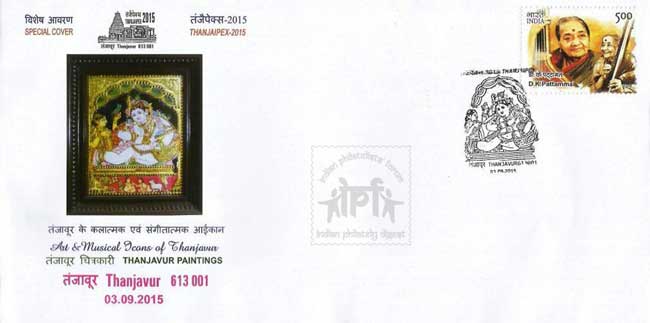
Third special cover was issued on Thanjavur dolls (Special Cover approval no. TN/26/2015).
A tanjore doll is a type of traditional Indian bobble head or roly-poly toy made of terracotta material. Its centre of gravity and total weight is concentrated at its bottom-most central core all the time so as to present a dance-like continuous movement with slow-damping oscillations. Hence it comes back to its normal seating position automatically after being tilted / disturbed anyway. Round-bottomed toys are unique, but other standing types are available too. Traditionally these toys are handmade and their exteriors are painted to an intrinsic sense of humour.

Fourth special cover was issued on Thanjavur art plates (Special Cover approval no. TN/27/2015).
The creation of the Tanjore metal plate is credited to Raja Serfoji II (1797-1832), the Maratha ruler of Thanjavur (or Tanjore), who asked his royal artisans to create an object that would reflect the glory of his kingdom. Thanjavur art plates are traditional metal craft of Tamilnadu with its intricated workmanship and value. The popular Thanjavur Art plates feature designs of deities, birds, flower and geometric patterns beaten out from the back of copper and silver sheets. These are then encrusted on a brass round plate, tray or pot (Kudam) or cup (panchapathra). Generally the designs follow a theme, mythological or non-religious and sometimes special motifs of requirement.
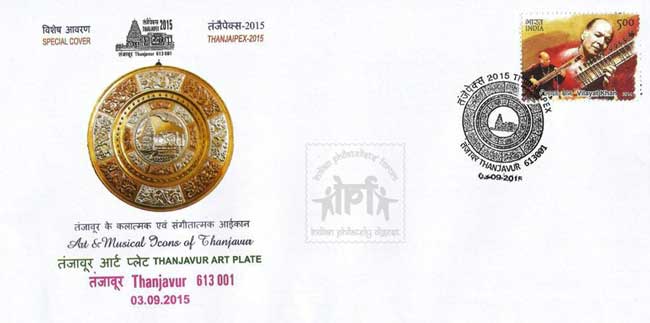
Fifth special cover was issued on Thanjavur Thavil (Special Cover approval no. TN/28/2015).
The Thavil or Tavil is a barrel shaped drum from Tamil Nadu. It is used in temple, folk and Carnatic music, often accompanying the nadaswaram. The thavil and the nadaswaram are essential components of traditional festivals and ceremonies in South India. In folk music contexts, a pair of wider, slimmer sticks is sometimes used. Thanjavur is famous for thavil, so called Thanjavur Thavil. In Kollywood Filmi songs thavils are mostly used, Notable movies: "Thillaanaa Mohanambal", "Paruthiveeran", "Karagattakaran".
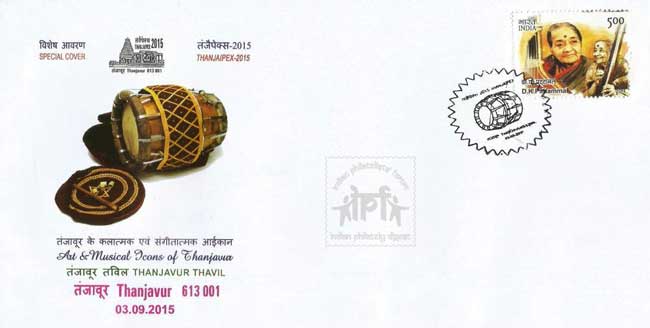
A stamp booklet on “International day of Yoga” Stamp was also released on the occasion containing Block of 4 of International day of Yoga stamps. The jacket of booklet is printed with lenticular printing and it is priced at Rs. 100 each. Limited numbers of presentation packs were also made containing 5 special covers.
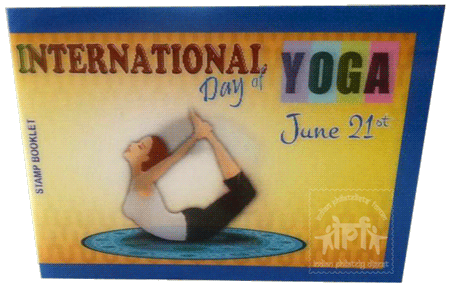
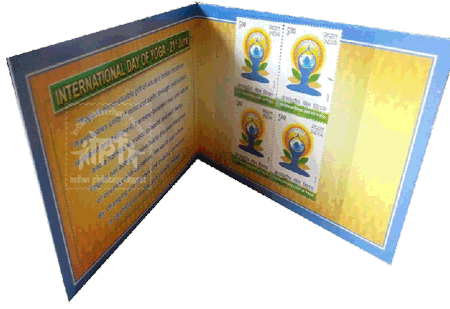
On 4th September 2015 Valedictory function was held in presence of Chief Postmaster General, Tamilnadu Circle, Dr. Charles Lobo. A special cover was also released on Manora Fort, Thanjavur.
The Manora fort is situated 65 km away from Thanjavur. The fort was built by Maratha ruler Serfoji II in 1814–1815 to commemorate the successful advance of the British over Napoleon Bonaparte. It is an 8-storied, hexagonal tower, which is 23-meters high overlooking the Bay of Bengal. The fort derives its name Manora, from the word Minaret.
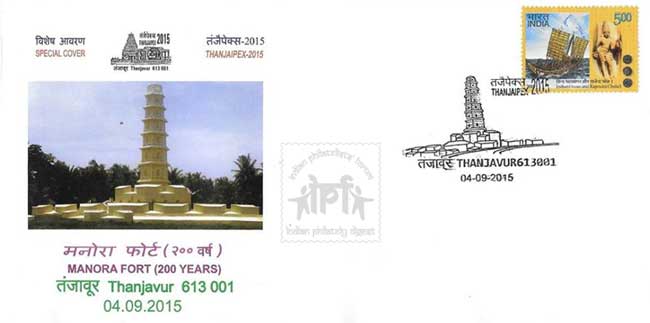
Covers Courtesy: R. Kasinath, Thanjavur
Special Cover on Dr. M. S. Sanjeevi Rao - 3rd September 2015.
Dr. Mallipudi Srirama Sanjeevi Rao born on 3rd May, 1929 at Bhimunipatnam in Visakhapatnam district, was a visionary and social reformer who followed in the footsteps of his father Mallipudi Pallam Raju, a freedom fighter and former minister of Andhra Pradesh. Shri Rao was educated at Guindy Engineering College, Madras and Imperial College of Science and Technology, London. An electronics engineer, Dr Rao had served in several companies and was associated with many organisations. He founded micro ceramics, the first electronic component industry in India.
He was a man of several personal accomplishments before he entered politics. Dr. M. S. Sanjeevi Rao served as a Member of the Andhra Pradesh Legislative Assembly in 1974-76 before being elected to the Lok Sabha in 1971, 1977 and 1980. He served as a Union Deputy Minister for Electronics during 1982-84 and later as Chairman of the Electronics Commission. Shri Rao was responsible for transforming Kakinada into an industrial zone by developing the previously inaccessible coastline of Kakinada with the World Bank and Asian Development Bank funds. The Coastal Corridor and highway was also developed giving fishermen access to the mainstream markets. The Kakinada port and fishing harbour were built under his guidance. He had also played a role in bringing the Nagarjuna and Godavari fertilizer plants to Kakinada. He passed away on 3rd September 2014 at Kakinada after suffering a cardiac arrest.
A special cover on Dr. M. S. Sanjeevi Rao was released on 3rd September 2015 at a function held at JNTUK Alumni Auditorium, Kakinada by Shri M. Sampath, Postmaster General, Vijayawada Region (Special Cover approval no. AP/26/2015). Senior Congress Leaders of Telangana and Andhra Pradesh also participated in the cover release function.
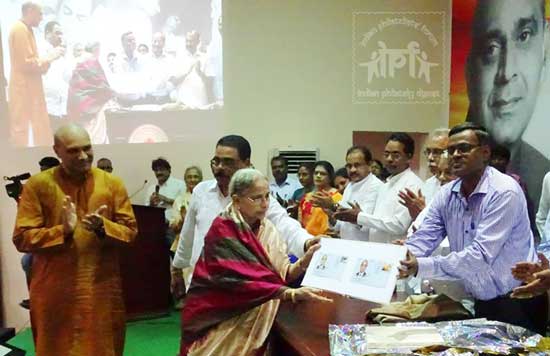
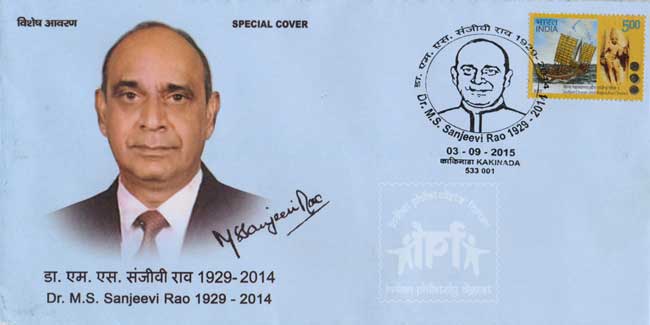
Courtesy: Sagi Srinivas Raju, Hyderabad
Commemorative Stamps on “Women Empowerment” - 2nd September 2015.
The subject of empowerment of women has becoming a burning issue all over the world including India since last few decades. Inequalities between men and women and discrimination against women have also been age-old issues all over the world. Thus, women’s quest for equality with man is a universal phenomenon.
The National Mission for Empowerment of Women (NMEW) was launched by the Government of India on International Women’s Day in 2010 with the aim to strengthen the processes which promote holistic development and empowerment of women, gender equality and gender justice through inter-sectoral convergence of programmes that impact women, forge synergy among various stakeholders and create an enabling environment conducive to social change.
The Department of Posts organized a nation-wide competition inviting entries for the designs of commemorative stamps on the theme “Women Empowerment”. Based on the selected entries, a set of four stamps and a miniature sheet on the theme was released by Hon’ble Minister of Communication & Information Technology Shri Ravi Shankar Prasad at a function held at Banquet Hall, 3rd Floor, Ashoka Hotel, Chanakyapuri, New Delhi on 2nd September, 2015 in presence of Shri A. B. Joshi, Member Technology, Shri S. K. Sinha, Member HRD, Shri Vasumitra, Chief Postmastrer General, Delhi from India Post and BJP MP Meenakshi Lekhi.


Photo Courtesy: PIB


